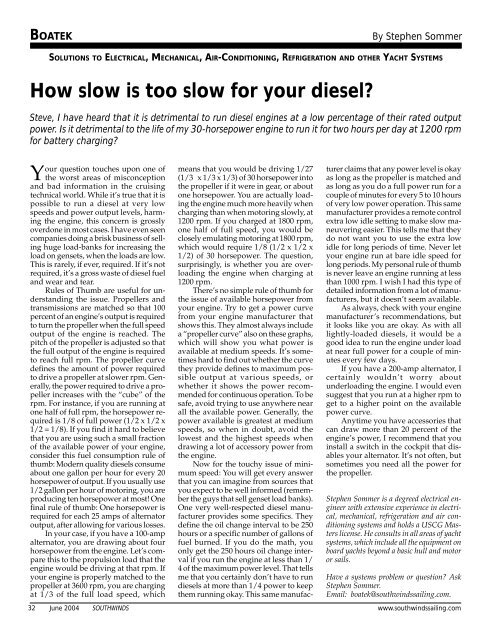Southwinds Sailing June 2004 - Southwinds Magazine
Southwinds Sailing June 2004 - Southwinds Magazine
Southwinds Sailing June 2004 - Southwinds Magazine
- No tags were found...
Create successful ePaper yourself
Turn your PDF publications into a flip-book with our unique Google optimized e-Paper software.
BOATEKBy Stephen SommerSOLUTIONS TO ELECTRICAL, MECHANICAL, AIR-CONDITIONING, REFRIGERATION AND OTHER YACHT SYSTEMSHow slow is too slow for your diesel?Steve, I have heard that it is detrimental to run diesel engines at a low percentage of their rated outputpower. Is it detrimental to the life of my 30-horsepower engine to run it for two hours per day at 1200 rpmfor battery charging?Your question touches upon one ofthe worst areas of misconceptionand bad information in the cruisingtechnical world. While it’s true that it ispossible to run a diesel at very lowspeeds and power output levels, harmingthe engine, this concern is grosslyoverdone in most cases. I have even seencompanies doing a brisk business of sellinghuge load-banks for increasing theload on gensets, when the loads are low.This is rarely, if ever, required. If it’s notrequired, it’s a gross waste of diesel fueland wear and tear.Rules of Thumb are useful for understandingthe issue. Propellers andtransmissions are matched so that 100percent of an engine’s output is requiredto turn the propeller when the full speedoutput of the engine is reached. Thepitch of the propeller is adjusted so thatthe full output of the engine is requiredto reach full rpm. The propeller curvedefines the amount of power requiredto drive a propeller at slower rpm. Generally,the power required to drive a propellerincreases with the “cube” of therpm. For instance, if you are running atone half of full rpm, the horsepower requiredis 1/8 of full power (1/2 x 1/2 x1/2 = 1/8). If you find it hard to believethat you are using such a small fractionof the available power of your engine,consider this fuel consumption rule ofthumb: Modern quality diesels consumeabout one gallon per hour for every 20horsepower of output. If you usually use1/2 gallon per hour of motoring, you areproducing ten horsepower at most! Onefinal rule of thumb: One horsepower isrequired for each 25 amps of alternatoroutput, after allowing for various losses.In your case, if you have a 100-ampalternator, you are drawing about fourhorsepower from the engine. Let’s comparethis to the propulsion load that theengine would be driving at that rpm. Ifyour engine is properly matched to thepropeller at 3600 rpm, you are chargingat 1/3 of the full load speed, which32means that you would be driving 1/27(1/3 x 1/3 x 1/3) of 30 horsepower intothe propeller if it were in gear, or aboutone horsepower. You are actually loadingthe engine much more heavily whencharging than when motoring slowly, at1200 rpm. If you charged at 1800 rpm,one half of full speed, you would beclosely emulating motoring at 1800 rpm,which would require 1/8 (1/2 x 1/2 x1/2) of 30 horsepower. The question,surprisingly, is whether you are overloadingthe engine when charging at1200 rpm.There’s no simple rule of thumb forthe issue of available horsepower fromyour engine. Try to get a power curvefrom your engine manufacturer thatshows this. They almost always includea “propeller curve” also on these graphs,which will show you what power isavailable at medium speeds. It’s sometimeshard to find out whether the curvethey provide defines to maximum possibleoutput at various speeds, orwhether it shows the power recommendedfor continuous operation. To besafe, avoid trying to use anywhere nearall the available power. Generally, thepower available is greatest at mediumspeeds, so when in doubt, avoid thelowest and the highest speeds whendrawing a lot of accessory power fromthe engine.Now for the touchy issue of minimumspeed: You will get every answerthat you can imagine from sources thatyou expect to be well informed (rememberthe guys that sell genset load banks).One very well-respected diesel manufacturerprovides some specifics. Theydefine the oil change interval to be 250hours or a specific number of gallons offuel burned. If you do the math, youonly get the 250 hours oil change intervalif you run the engine at less than 1/4 of the maximum power level. That tellsme that you certainly don’t have to rundiesels at more than 1/4 power to keepthem running okay. This same manufacturerclaims that any power level is okayas long as the propeller is matched andas long as you do a full power run for acouple of minutes for every 5 to 10 hoursof very low power operation. This samemanufacturer provides a remote controlextra low idle setting to make slow maneuveringeasier. This tells me that theydo not want you to use the extra lowidle for long periods of time. Never letyour engine run at bare idle speed forlong periods. My personal rule of thumbis never leave an engine running at lessthan 1000 rpm. I wish I had this type ofdetailed information from a lot of manufacturers,but it doesn’t seem available.As always, check with your enginemanufacturer’s recommendations, butit looks like you are okay. As with alllightly-loaded diesels, it would be agood idea to run the engine under loadat near full power for a couple of minutesevery few days.If you have a 200-amp alternator, Icertainly wouldn’t worry aboutunderloading the engine. I would evensuggest that you run at a higher rpm toget to a higher point on the availablepower curve.Anytime you have accessories thatcan draw more than 20 percent of theengine’s power, I recommend that youinstall a switch in the cockpit that disablesyour alternator. It’s not often, butsometimes you need all the power forthe propeller.Stephen Sommer is a degreed electrical engineerwith extensive experience in electrical,mechanical, refrigeration and air conditioningsystems and holds a USCG Masterslicense. He consults in all areas of yachtsystems, which include all the equipment onboard yachts beyond a basic hull and motoror sails.Have a systems problem or question? AskStephen Sommer.Email: boatek@southwindssailing.com.<strong>June</strong> <strong>2004</strong> SOUTHWINDS www.southwindssailing.com
















